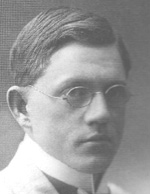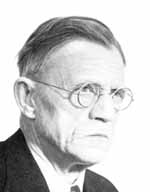Sinological Profiles
Bernhard Karlgren
5 Oct 1889 - 20 Oct 1978
Karlgren was nothing if not concentrated. He was a model of concentration. His concentration laid the foundation for the modern historical study of the Chinese language, and made him incidentally the founding figure of Swedish Sinology.
He did his undergraduate work at Uppsala at a time when dialect studies were popular. He began with Swedish (under the Slavic specialist and comparative phonologist J A Lundell), but soon conceived a desire to apply the same methods of comparative phonetic reconstruction to Chinese. On receiving his degree in 1909, he spent November and December studying Chinese with Ivanov at St Petersburg, and in March of 1910 went on to China, where he in less than two years he gathered materials from 24 Chinese dialects. Then it was more academic training, first two months in London, in early 1912, and then to Paris, where he studied with Chavannes from September 1912 to April 1914. He was awarded his doctorate from Uppsala for a preliminary effort: the reconstruction of the Tang pronunciation of three thousand characters. He became a Professor of East Asian Philology at Goteburg University in 1918, with responsibilities for teaching both Chinese and Japanese. He continued to extend and refine his dissertation work, and made a second visit to China in 1922. A more comprehensive version of his phonological studies appeared in 1926 under the title Etudes sur la Phonologie Chinoise. This was the last of his scholarly works to be written in French; henceforth it would be English.
LODEN: In 1918, Karlgren was appointed Professor of East Asian Philology at the University of Gothenburg, where he taught Chinese as well as Japanese. In 1922 he visited China for the second and last time. He left Gothenburg in 1939 and moved to Stockholm, where he became Director of the Museum of Far Eastern Antiquities and editor of its Bulletin (referred to below as BMFEA), in which he published many of his most important writings.
Having reconstructed the phonetics of Ancient Chinese, Karlgren set about reconstructing what he termed Archaic Chinese, i.e. the language spoken in China during the first part of the first millennium B. C. For this work, he relied heavily on the rhymes in the Shijing ?? (Book of Odes). His reconstructions of ancient and archaic Chinese can all be found in Grammata serica, first published in 1940, and then revised and published as Grammata serica recensa in 1967. In 1957 he published A Compendium of Phonetics in Ancient and Archaic Chinese, which describes the materials, methods and results of his reconstructions.
The reconstructions of Ancient and Archaic Chinese constitute the core of Karlgren's oeuvre, but he also achieved outstanding results in other fields. He made use of his reconstructions to go a little further in reflections about Chinese antiquity, especially in his philological studies, than scholars before him had been able to do. His translations of and glosses on the Shijing ??and the Shujing ?? are exemplary in this regard.11 Karlgren also made significant contributions to the study of ancient Chinese religion and of early bronzes.
After his doctoral dissertation, which he wrote in French, Karlgren wrote most of his scholarly works in English. In Swedish he published numerous popular works on Chinese language, culture and history. In the 1940's, he published three novels under the pen name Klas Gullman. These novels were meant to be entertaining reading for the educated public in the best British tradition. Undoubtedly, those of us who understand some of his scholarship and are also interested in literature would feel that he was much more accomplished as a sinologist than a novelist.
I did not know Bernhard Karlgren personally, although I met him a couple of times. My understanding of his personality is thus based on reading and hearsay. His scholarly writings may be characterized as terse and laconic, and this style expressed his lucid and incisive intellect. For him the task of scholarship was to try to clarify what could be clarified, not to engage in speculation about matters that could not be determined. Underneath his terseness there was passion. This came to the surface, for example, in his defence of the Han scholar Liu Xin ?? against the allegations that the Old Text School versions of pre-Qin Texts were forgeries.12 This impassioned defence was also an expression of his commitment to truth and his predilection for facts rather than speculations. It seems to me that his mind was in some ways closely akin to some of the great masters of textual criticism in the Qing Dynasty, whom he also admired, such as Wang Niansun ??? (1744-1832), Duan Yucai ??? (1735-1815) and Dai Zhen ?? (1724-1777).
Karlgren respected and admired great Chinese scholars as well as many expressions of Chinese culture. But he never mystified China. He was convinced that Chinese texts could be analyzed and understood just as texts in other languages. He was a cosmopolitan. For him scholarship constituted one universe, albeit with many subdivisions, and he never doubted that the methods of comparative phonological studies, first developed for the analysis of European languages, could also be applied to the study of Chinese. I see it as a characteristic trait of his personality that from his early days he was more struck by the similarities between Chinese and European cultures than by any perception of essential and unbridgeable differences. We may find an interesting expression of this in a letter he wrote to his fiancée Inna in June 1910, during his first visit to China:
Coming out here one is not at all amazed, as everyone assures one, that everything is so different from our own culture. On the contrary I keep feeling surprised at the fact that the material culture is so utterly similar to ours. As early as 2000 years B. C., the Chinese already used forearm (cubit) as a measure and divided this into inches. Is not such a detail marvellous?13
References
- Göran Malmqvist. Bernhard Karlgren: Ett Forskarporträtt. (Stockholm) Norstedts 1995
Magnus Fiskesjo and David Pankenier contributed to this profile.
9 June 2004 / Contact The Project / Exit to Sinology Page


